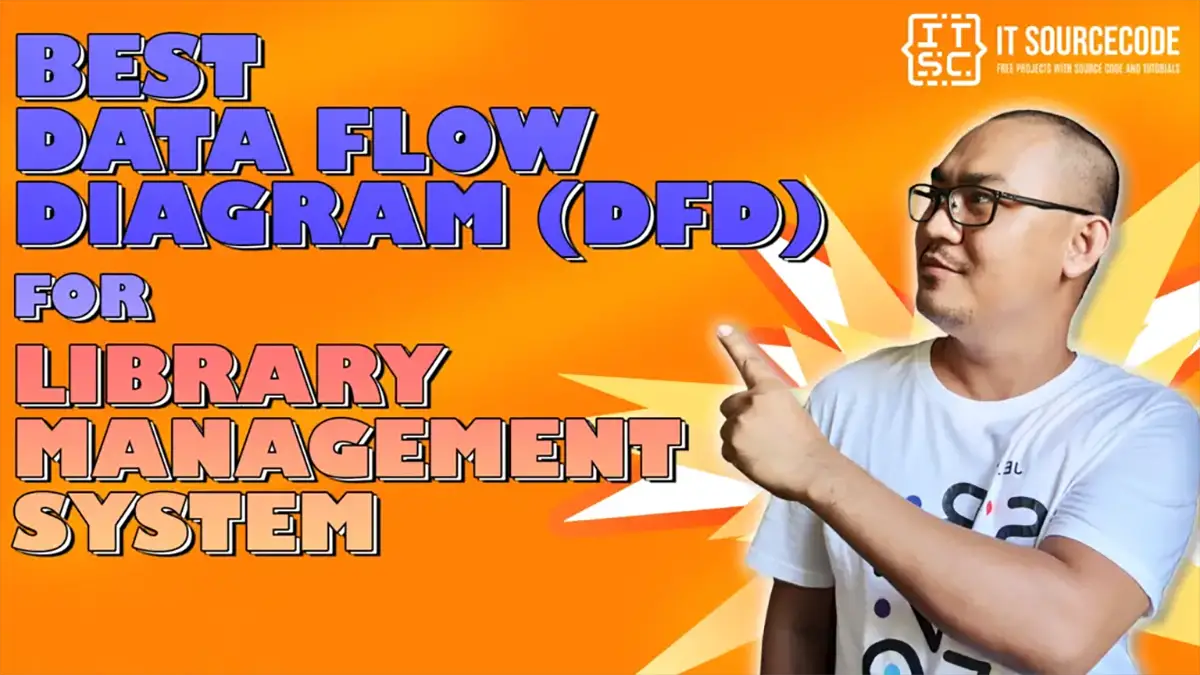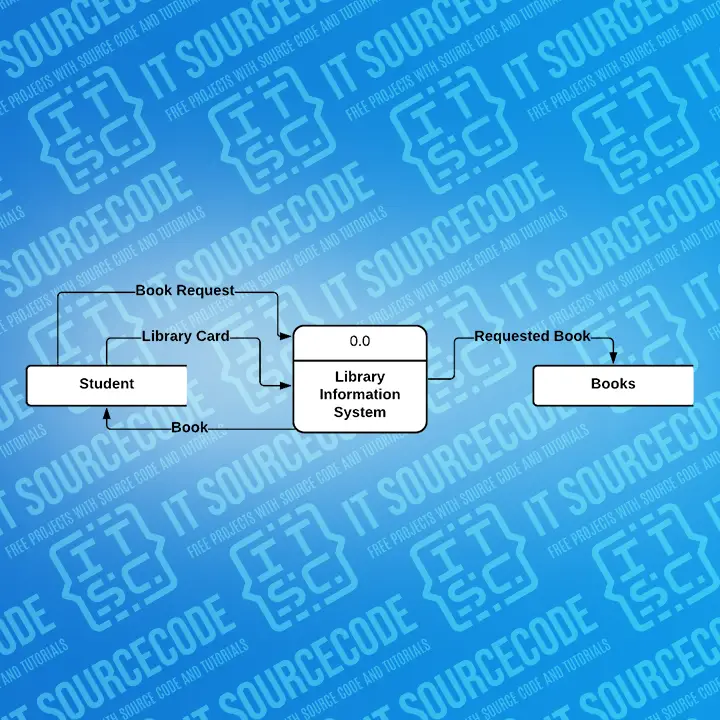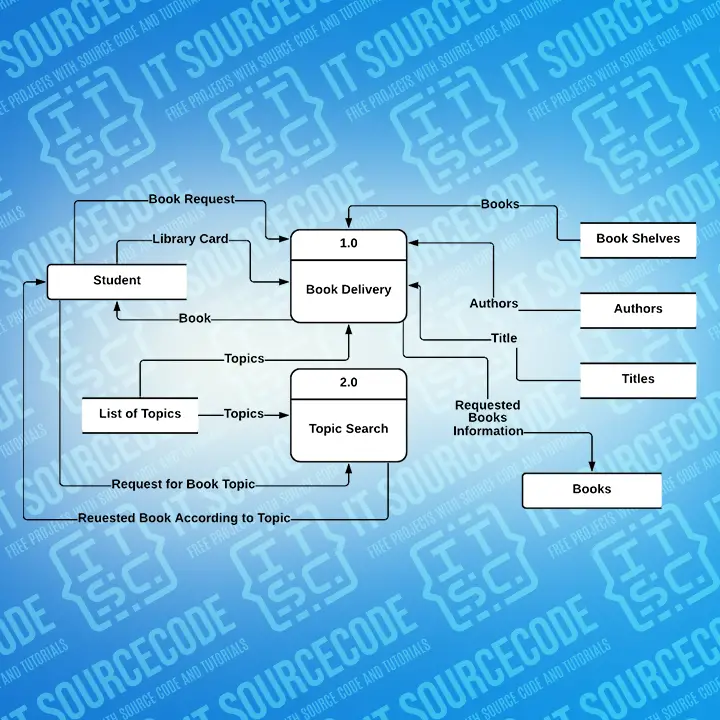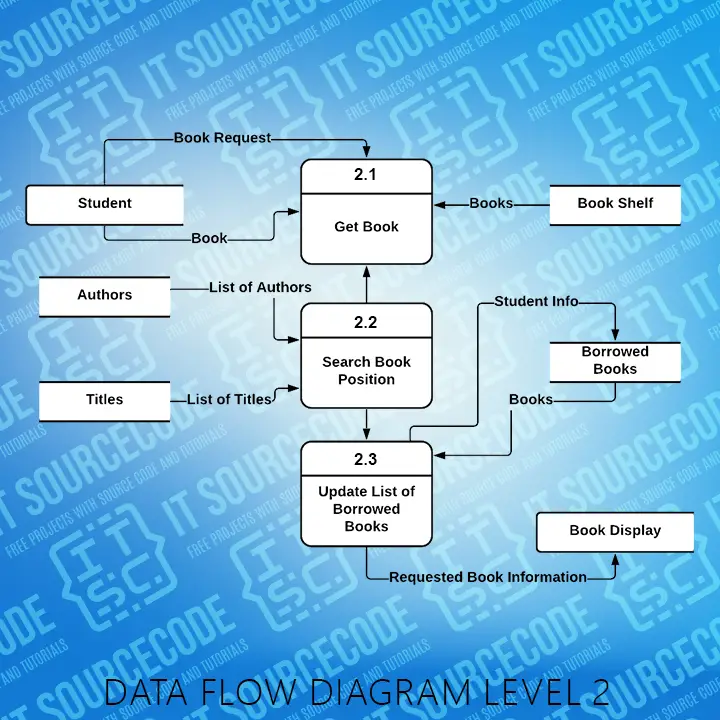The DFD for the Library Management System is a representation of the overall flow of data and the transformations made when data are processed by the library management system.
In addition, It also represents and describes the DFD for library information systems through input and output processes.
For the Library Management System, the inputs include:
- Book Information
- Book Request
- Library Card
Book information is fed into the system for book management purposes and business processes.
The information will be available for monitoring and tracking books between borrowers and library shelves.
The book request is input from book borrowers to the library system. This system then filters their request and notifies the librarian that there is a request to purchase or borrow a book.
Library cards will serve as the borrower’s pass to borrow or purchase books from the library. This card contains their information which should be present in the system.
The mentioned inputs will also generate outputs as a result. This library management system data flow diagram will show the following outputs:
- Books
- Reports
Books and Reports are the library system’s potential outputs based on the given inputs.
The books will be distributed to the borrowers or buyers as long as it is available.
The library system will process the book request and eventually release the book when confirmed by the librarian.
Reports will enable the librarian to trace the borrowed books and monitor their bookshelves for available books. This report will include important details of the book and the borrower/buyer.
Reminder: DFD is not part of the Library Management System UML Diagrams, but they complement in explaining the project activities, behaviors, interactions, and structure.
Library Management System Context Diagram
A context diagram (level 0 data-flow diagram) clarifies the library system’s boundaries.
It shows how information moves between the system and the external entities. A single process shows the whole concept of the software.
The diagram’s arrowheads determine the direction of the data input that flows. Students (Borrowers) and Books are the external entities that cause the library system to deliver a function.
0.0 “Library Management System” is the label of the main process. This indicates that 0.0 is the basis of the preceding levels.
Generally, the library management system DFD level 0 is the starting point of the following diagrams.
Library Management System Level DFD 1
A 1st level DFD of the Library describes each of the major sub-processes that build the entire system. This level is the “expanded perspective” of the context diagram.
At this level, the single process is explained by stressing its sub-processes which include:
- Book Delivery
- Topic Search
Book delivery is the process where the system releases books according to the given request. The system will receive input from the external entity and then inform the main user.
Topic search/es will be performed by the system or by the librarian. This enables the admin to know if the requested book is available for purchase or borrowing. Either way, the system will provide an output.
The system data store (database) includes:
- Book Shelves
- Authors
- Titles
- Topics
The level 1 data flow diagram for the library management system explains the context diagram at a high level.
Level 2 DFD for Library Management System
DFD level 2 goes one step deeper into the process of level 1. It is used to show or describe important processes from level 1. Therefore, this level is the deepened version of DFD level 1.
In level 2 DFD for the library management system, the process “Topic Search” (2.0) is explained to reveal the included processes under topic search.
The sub-process 2.0 includes important processes such as:
- 2.1 Get Book
- 2.2 Search Book Position
- 2.3 Update List of Borrowed Books (Reports)
These processes specify where the mentioned inputs and outputs enter, store, and exit. In short, DFD level 2 highlights the important system data flow.
This means that the highlighted processes should be present in the actual flow of information.
Remember that this level is only applied when you need to address additional processes under the sub-process in level 1. This level can also come in multiple forms depending on how many sub-processes should you emphasize.
Additionally, this level is not required in some circumstances. As long as you can explain the library system’s concept in levels 0 and 1, then your data flow diagram will be great.
Library Management System Data Flow Diagram Pdf
Conclusion
Levels 0, 1, and 2 of a Data Flow Diagram (DFD) work together to show the exact flow of data processed by a Library Management System.
The context diagram focuses on the overall scope and users of the library management system. It shows the whole process in a single step to easily understand the system’s concept.
DFD level 1 expands the view from the main process and shows the flow by including the sub-process in library management. This level is useful for the developer’s side because it stresses the system’s processes.
Additionally, level 1 places more emphasis on the databases used to store the inputs from external entities. Users also used the databases to get the outputs and reports they needed.
Levels 0 and 1 describe the whole concept of the library management system. However in some scenarios, users and developers add the DFD level 2 to emphasize the important processes under the sub-processes in level 1.
DFD level 2 is not required all the time; it is only used when users need to explain further about the library management system functions and DFD (data flow diagram).
Related Articles
- DFD for Employee Management System
- DFD for School Management System
- Blood Bank Management System DFD
- DFD for Bank Management System
- DFD for Loan Management System
- Doctor Appointment System DFD
Inquiries
If you have inquiries or suggestions about DFD for the Library Management System, just leave us your comments below. We would be glad to hear to concerns and suggestions and be part of your learning.




